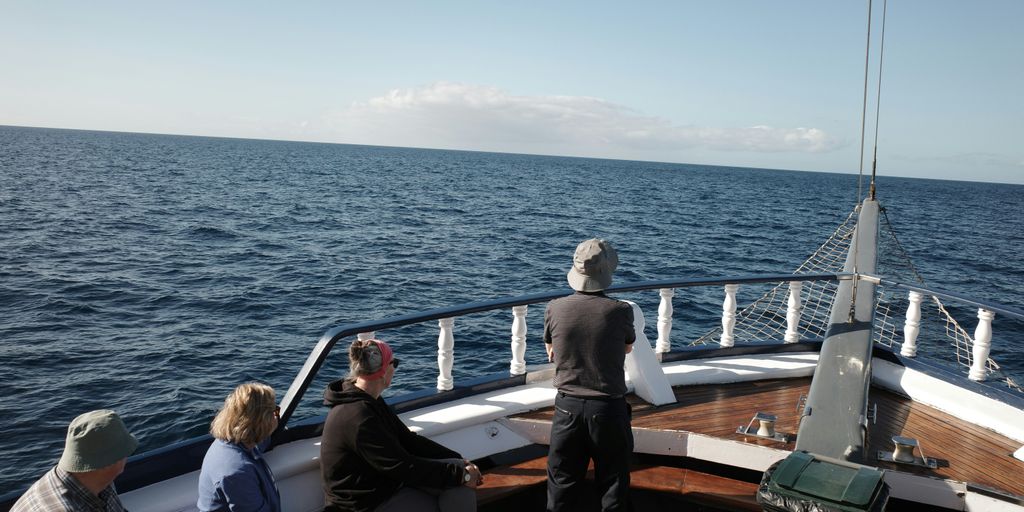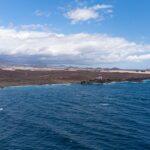Thinking about a family trip to the Galapagos? It’s a pretty amazing idea. Imagine your kids coming face-to-face with giant tortoises or watching sea lions play. Private Galapagos charters make this dream a reality, offering a way to explore these unique islands that’s perfect for families. It’s not just a vacation; it’s a chance for everyone to learn and connect with nature in a really special way. We’ll look at why these trips are so great for families and what you can expect.
Key Takeaways
- Private Galapagos charters offer tailored family adventures with unforgettable wildlife encounters and custom itineraries for young explorers.
- The Galapagos Islands serve as a living classroom, providing hands-on learning about evolution, marine biology, and unique ecosystems for children.
- Family-friendly activities include snorkeling with marine life, kayaking, exploring volcanic landscapes, and engaging educational programs.
- Experienced naturalists and scientists provide expert guidance, making learning interactive and fun for kids and teens.
- Choosing private Galapagos charters ensures safety, comfort, and easy access to remote islands, creating lasting family memories.
Why Choose Private Galapagos Charters for Family Adventures
Thinking about a family trip that’s more than just a vacation? The Galapagos Islands offer an experience that really sticks with you, and doing it on a private charter makes it even more special for everyone. It’s not just about seeing cool animals; it’s about how you see them and what you learn together.
Unforgettable Wildlife Encounters for All Ages
Seriously, the animals in the Galapagos are something else. They haven’t really learned to be scared of people, which means you can get pretty close. Imagine your kids seeing a blue-footed booby do its funny dance or watching sea lions swim right up to you while you’re snorkeling. It’s not like a zoo; it’s real life happening right in front of you. This kind of up-close interaction is amazing for kids and adults alike. You’ll find yourself talking about these moments long after you get home.
Tailored Itineraries for Young Explorers
One of the best parts of a private charter is that you can sort of shape the trip around what your family likes. If your kids are really into marine life, you can spend more time snorkeling or kayaking in spots known for sea turtles and penguins. If they’re fascinated by volcanoes, you can focus on islands with cool lava fields and tunnels. This flexibility means no one gets bored, and everyone feels like the trip is made just for them. It’s a great way to keep everyone engaged, especially the younger ones.
Creating Lasting Family Memories
When you’re all together, experiencing something as unique as the Galapagos, it really brings people closer. You’re sharing these incredible sights and sounds, learning new things, and maybe even facing a few gentle challenges, like figuring out how to kayak. These shared adventures become the stories you’ll tell for years. It’s a chance to disconnect from the everyday hustle and reconnect with each other in a place that feels like another planet. A private charter makes this whole experience feel more intimate and personal, which is perfect for building those strong family bonds. You can even explore remote islands with ease, making your adventure truly unique. Explore private yacht options.
The islands themselves are like a living museum, and experiencing them on a private charter means you get to set the pace and focus on what truly captures your family’s imagination. It’s an investment in shared experiences that pay dividends in memories for a lifetime.
Galapagos Islands: A Living Laboratory for Children
Learning About Evolution and Natural Selection
The Galapagos Islands are basically a real-life science class, and way more fun than any textbook. Imagine seeing firsthand how animals have changed over time to survive on these unique islands. It’s like stepping into Darwin’s footsteps, but with way better views. Kids can actually observe creatures that exist nowhere else on Earth, and because they haven’t dealt with many predators, they’re pretty chill about people. This means you can get surprisingly close to see things like the famous blue-footed boobies or the ancient giant tortoises. It’s a fantastic way to grasp concepts like natural selection without even trying.
The islands offer a unique chance to witness evolution in action, making abstract scientific ideas tangible for young minds. It’s an experience that sticks with you, sparking curiosity long after the trip ends.
Hands-On Marine Biology Experiences
Forget stuffy labs; the ocean here is the lab! When you go snorkeling, it’s not just about seeing fish; it’s about observing a whole ecosystem. You might swim with playful sea lions, see penguins darting through the water, or spot sea turtles gliding by. Many trips include activities like plankton tows, where you can actually collect tiny marine life and then look at it under a microscope back on the boat. It’s a really cool way to understand the smaller, often unseen, parts of ocean life. You can even get a chance to learn how to pilot a Zodiac boat, which feels like a real adventure.
Discovering Unique Island Ecosystems
Each island in the Galapagos has its own special vibe and its own set of creatures. You’ll see how different environments shape the animals living there. For instance, one island might have giant tortoises with domed shells because they eat grass low to the ground, while another might have tortoises with saddleback shells, allowing them to reach higher vegetation. It’s fascinating to see these differences up close. You’ll explore volcanic landscapes, walk through lava tunnels, and see how life finds a way to thrive even in harsh conditions. It’s a great way to appreciate the diversity of our planet.
Here’s a quick look at what you might encounter:
- Santa Cruz Island: Visit the Charles Darwin Research Station and see giant tortoises being cared for.
- Bartolome Island: Explore dramatic lava formations and snorkel with sea lions and penguins.
- Santiago Island: Look for fur seals and explore tide pools teeming with sea stars and octopuses.
These experiences make learning about biology and ecology incredibly engaging for the whole family, turning a vacation into an unforgettable educational journey. You can even get a special "Galapagos Explorer" license on some trips, which is a fun memento of all the amazing things you’ll learn and see. This kind of trip is a fantastic way to connect with nature and each other, making it a truly special family adventure. For families looking for an educational and exciting trip, the Galapagos is an excellent choice, offering a chance to explore a unique natural world. You can find more information on family-friendly travel options at Galapagos family tours.
Family-Friendly Activities on Private Galapagos Charters
Snorkeling with Playful Sea Lions and Penguins
Imagine your kids’ faces when they first see a sea lion darting through the water right beside them! Snorkeling in the Galapagos is an absolute blast for all ages. The marine life here is so used to people, you’ll often find curious sea lion pups swimming right up to say hello. It’s like swimming in a giant, natural aquarium. And if you’re lucky, you might even spot the endemic Galapagos penguins zipping through the water – they’re surprisingly fast! Even if your little ones aren’t strong swimmers, many boats offer glass-bottom Zodiacs, so everyone can get a peek at the underwater world without getting wet.
Kayaking and Paddleboarding Along Pristine Shores
Want a more relaxed way to explore the coastline? Kayaking and paddleboarding are fantastic options. You can glide along calm bays, getting up close to marine iguanas basking on the rocks or spotting sea turtles paddling beneath you. It’s a great way for kids to feel a sense of independence while staying safe and close to the boat. Plus, it’s a quiet way to appreciate the sheer beauty of the islands without disturbing the wildlife. You might even paddle past a colony of blue-footed boobies nesting on the cliffs.
Exploring Volcanic Landscapes and Lava Tunnels
The islands themselves are a playground of geological wonders. Many itineraries include walks across dramatic lava fields, where you can see how life slowly reclaims the land. Exploring lava tunnels is another adventure that kids absolutely love – it feels like stepping into another world! These natural formations, created by ancient volcanic activity, offer a glimpse into the raw power that shaped the Galapagos.
- Walk across stark volcanic landscapes.
- Discover hidden lava tunnels.
- Observe unique plant life adapting to harsh environments.
These activities aren’t just fun; they’re a living lesson in geology and ecology. Seeing how life persists and adapts in such a unique environment really sticks with you.
Expert Guidance for Young Naturalists
Learning from Experienced Naturalists and Scientists
Having a really good guide makes all the difference when you’re exploring a place like the Galapagos, especially with kids. These aren’t just any guides; they’re seasoned naturalists, often with backgrounds in biology or conservation. They know the islands inside and out, from the best spots to see blue-footed boobies doing their dance to where the sea lions like to nap. They bring the islands to life with stories and facts that kids can actually connect with. It’s like having a walking encyclopedia who’s also great at spotting wildlife. They can point out subtle things you’d totally miss, like a tiny lava lizard camouflaged on a rock or explain why a particular bird has such bright feet. It turns a simple walk into a real learning adventure.
Interactive Programs for Kids and Teens
Many family-friendly charters go beyond just pointing things out. They have programs specifically designed to get kids involved. Think about getting a special field notebook to sketch or write down what you see – maybe track the different types of finches or note down the behaviors of the marine iguanas. Some trips even let kids try piloting a Zodiac boat, which is a huge hit. They can earn a sort of "Galapagos Explorer" license for it! It’s all about making the learning hands-on and fun, so they’re not just passively listening. They’re actively participating in the discovery process.
Earning a ‘Galapagos Explorer’ License
One of the coolest things some expeditions offer is the chance for kids to earn a "Galapagos Explorer" license. This usually happens after they’ve participated in certain activities, like learning to drive a small inflatable boat (a Zodiac) under careful supervision. It’s a fun way to give them a sense of accomplishment and a tangible reminder of their adventure. It makes them feel like they’re really part of the exploration team. Imagine the pride when they can tell their friends they’re officially licensed Galapagos explorers!
The guides often tailor their explanations to different age groups, making sure even the youngest travelers can grasp concepts like evolution or adaptation. They use simple language and relatable examples, turning complex scientific ideas into engaging stories. This approach ensures that the educational aspect of the trip is both accessible and memorable for everyone in the family.
Navigating the Galapagos Archipelago with Your Family
The Advantages of Expedition Cruising
Getting around the Galapagos can feel a bit tricky at first. You’ve got 13 main islands and a bunch of smaller ones spread out over a big chunk of ocean. The really cool thing is that almost all of it is a national park, and most islands don’t have anyone living on them. This means there are some pretty strict rules to keep everything wild and pristine. You can’t just hop around on your own boat; you need a certified guide, and there’s a limit on how many people a guide can look after. Plus, flying between islands isn’t really an option, and speedboats can be a bumpy ride, especially with kids.
This is where expedition cruising really shines for families. While everyone is sleeping, the ship moves you from one amazing spot to the next. It’s how you get to those more out-of-the-way islands that are just bursting with unique wildlife and landscapes. Your guides are right there with you, explaining everything you see. It’s a much smoother way to experience the diversity of the islands.
Reaching Remote Islands with Ease
Because you’re on a ship, you can get to places that are harder to reach otherwise. Think islands like Fernandina or Genovesa – they’re pretty special and not always on the usual tourist path. The ship acts as your base, taking you right to these wilder areas. It means you get to see a wider variety of animals and scenery without all the hassle of trying to figure out separate transport for each island.
Understanding National Park Regulations
It’s important to know that the Galapagos National Park has rules to protect the environment. These rules are in place to make sure the animals and their homes stay safe for years to come. For example, you’ll always be accompanied by a licensed naturalist guide when you go ashore. They know the rules and how to best experience the islands responsibly. It’s all about respecting the natural world you’re visiting.
- Guides are required for all excursions.
- Keep a respectful distance from all wildlife.
- Do not feed any animals.
- Stay on marked paths.
The park’s regulations are designed to preserve the unique nature of the Galapagos. Following them ensures that future generations can also experience the magic of these islands.
Best Times for a Family Galapagos Voyage
Year-Round Temperate Climate
Thinking about when to take your family to the Galapagos? The great news is, you really can’t go wrong. Because the islands sit right on the equator, they enjoy a pretty consistent, mild climate all year. Forget about those huge temperature swings you find in other vacation spots. This means you’ll have about 12 hours of daylight every single day, giving you plenty of time for outdoor adventures like hiking, swimming, and exploring. It’s always a good time to see the unique animals that call these islands home, like the giant tortoises and the famous blue-footed boobies.
Seasonal Marine Currents and Wildlife Viewing
While the weather is generally stable, there are some subtle shifts due to ocean currents. From roughly June to December, you’ll experience a cooler season. Then, from January to June, it’s warmer. These changes can influence what you see. For instance, the cooler months often mean richer marine life closer to shore, making snorkeling and observing sea lions or penguins particularly exciting. The warmer season can be better for seeing certain bird species nesting. It’s a bit like nature’s own calendar, with different highlights depending on when you visit. The islands truly have their own special charm on display no matter the season.
Peak Family Travel Periods
If you’re tied to school schedules, the most popular times for families to visit are during summer breaks and the Christmas and spring holidays. During these periods, you’ll find a lot of other families enjoying the islands, which can create a lively atmosphere. It’s a fantastic opportunity for kids to meet other young explorers. Many families find that traveling during these times leads to a really dynamic trip, full of shared discoveries and creating those lasting memories. It’s a great way to connect as a family while experiencing the wonders of the Galapagos, perhaps even snorkeling with playful sea lions.
Planning a trip during these busy times means booking well in advance is a smart move. You want to make sure you get the best spots on the boats and the activities you’re most excited about.
Safety and Comfort on Your Galapagos Family Charter
When planning a family trip to the Galapagos, safety and comfort are naturally top priorities. You’ll be glad to know that these islands are remarkably secure. National park regulations mean that every group of 16 explorers travels with a trained guide, so you’re never left to figure things out alone. Plus, the wildlife here isn’t dangerous to people; there are no natural predators that pose a threat.
Most ships that cruise the Galapagos are small, usually carrying no more than 100 guests. This makes for a more personal experience, and for kids, it means they can explore and gain a bit of independence in a safe, contained environment. There’s always a staff member around if they need anything. Many vessels even have a doctor on board, which is a great comfort knowing that medical help is readily available should anyone feel unwell or get a minor scrape.
Secure and Controlled Exploration Environments
Your family’s safety is paramount, and the expedition setup in the Galapagos is designed with this in mind. Guides are always present during excursions, ensuring that everyone stays within safe boundaries and follows park rules. This structured approach allows for worry-free exploration, letting you focus on the amazing sights and sounds around you.
Onboard Medical Support
It’s reassuring to know that medical assistance is accessible right on your ship. Many Galapagos charters include a medical professional or have arrangements for prompt medical attention. This is especially helpful when traveling with children, providing peace of mind for parents.
Intimate Ship Atmosphere for Independence
The smaller size of Galapagos vessels creates a cozy and manageable environment. Children can feel a sense of freedom to move around the common areas without getting lost in a crowd. This intimate setting allows them to develop a bit more self-reliance while still being under the watchful eyes of the crew, making it a great place for them to build confidence. You can find some wonderful family-friendly options for your adventure at luxurious safari lodges.
Educational Programs Enhancing Family Discovery
National Geographic Global Explorers Program
This is where the real learning happens, and it’s not like school at all. Onboard many family-friendly charters, especially those partnered with National Geographic, there’s a special program designed just for kids and teens. It’s called the National Geographic Global Explorers Program. Think of it as a way to get kids really involved with what they’re seeing. They get to do hands-on activities that connect them directly to the islands’ natural wonders. It’s all about making discoveries and learning in a fun, engaging way.
Field Notebooks for Wildlife Tracking
Every young explorer gets a field notebook. This isn’t just for doodling; it’s a tool for observation. Kids can record the animals they spot, sketch the plants they see, and write down interesting facts they learn from the guides. It’s a great way to keep track of all the amazing creatures and unique environments they encounter. It turns the whole trip into a personal scientific expedition. Keeping these notes helps them remember details and makes the learning stick long after they’re back home.
Microscopic Exploration of Marine Life
Ever wondered what’s in the water that you can’t see? Well, on these trips, kids get a chance to find out. They can participate in activities like plankton tows, where they collect tiny samples from the ocean. Then, they get to look at these samples under a microscope. It’s pretty amazing to see the small, unseen world of marine life up close. It really shows how much is going on, even in the smallest bits of water. It’s a fascinating look at the base of the ocean’s food web.
Planning Your Private Galapagos Charter
Choosing the Right Vessel Size
When you’re thinking about a private charter for your family in the Galapagos, the size of the boat really matters. Smaller vessels, often called yachts or expedition ships, are generally better for families. They can get into more secluded spots that bigger boats can’t reach, and you’ll find the atmosphere is much more personal. Think about how many people will be on board – fewer guests usually means more attention for everyone, especially the kids. Some charters are designed specifically for families, with activities and guides geared towards younger explorers. It’s worth looking into ships that carry fewer than 20 passengers for a more intimate experience.
Understanding Cruise Duration Options
Galapagos trips can vary quite a bit in length. Most family-friendly charters run anywhere from 7 to 10 days. A week is a good amount of time to see a lot without feeling rushed, but if you have more time, 10 days or even a bit longer lets you explore more remote islands and really soak it all in. Some companies might offer shorter trips, but for a true family adventure that covers a good chunk of the archipelago and allows for plenty of wildlife viewing and activities, aim for at least a week. It gives everyone, especially the kids, time to adjust and enjoy the unique environment.
Logistics of Travel to the Islands
Getting to the Galapagos involves a bit of planning. You’ll typically fly from mainland Ecuador (either Quito or Guayaquil) to one of the two main airports in the Galapagos: Baltra (serving Santa Cruz Island) or San Cristobal. Once you land, your charter’s crew will usually meet you to help with the transfer to your ship. It’s important to coordinate your flights with your cruise departure time. Most private charters handle the inter-island travel for you, moving between islands overnight while you sleep. This is a big plus for families, as it means less hassle and more time for exploring. Remember that park regulations require you to have a certified guide with you at all times when visiting the islands, and these guides are part of your charter experience.
The Galapagos National Park has strict rules to protect its delicate ecosystem. These include limits on visitor numbers per site and requirements for certified guides. Choosing a private charter means these logistics are handled for you, allowing your family to focus on the incredible wildlife and natural beauty. It’s a great way to see the islands responsibly.
Here’s a quick look at what to expect:
- Flights: Book round-trip flights from Quito or Guayaquil to the Galapagos (Baltra or San Cristobal).
- Transfers: Your charter company will arrange transfers from the airport to the ship.
- Park Entrance Fee: Be prepared for the Galapagos National Park entrance fee and the Transit Control Card fee, usually paid in cash upon arrival.
- Onboard Briefings: Pay attention to daily briefings from your guides about the day’s activities and any specific island rules.
Planning ahead makes the journey smooth, letting you focus on the amazing sights and sounds of the Galapagos. You can find great information on travel to the islands to help with your arrangements.
The Value of All-Inclusive Galapagos Family Cruises

When you’re planning a big family trip, especially somewhere as unique as the Galapagos, thinking about all the costs can get a little overwhelming. That’s where all-inclusive Galapagos family cruises really shine. They bundle so much into one price, making budgeting way simpler and letting you focus on the adventure, not nickel-and-diming. It means things like meals, snacks, and most activities are already covered. You won’t have to worry about paying extra for every snorkeling trip or guided walk.
Here’s a breakdown of what you typically get:
- All Meals and Snacks: From breakfast to dinner, plus those little bites in between, it’s all included. Think fresh, often locally inspired dishes that cater to different tastes, which is great when you have picky eaters.
- Included Activities: This is a big one. Your cruise fare usually covers guided excursions like Zodiac rides, nature walks, kayaking, and snorkeling. You get to experience the islands fully without constantly reaching for your wallet.
- Expert Guidance: You’ll have access to knowledgeable naturalists and scientists who lead all the excursions. They make learning about the unique wildlife and geology fun for everyone, from the youngest to the oldest.
Many companies also offer special perks for families. For instance, some provide discounts for children under 18, making it a bit more accessible for families traveling with multiple kids. There are also often dedicated programs designed specifically for younger travelers, giving them hands-on experiences and educational activities tailored to their age group. It’s a way to make sure everyone in the family feels engaged and gets the most out of the trip. You can find some great family-focused trips through providers like Lindblad Expeditions.
The beauty of an all-inclusive package is that it removes a lot of the financial guesswork. You know what you’re spending upfront, which allows for a more relaxed experience. This means more time spent watching sea lions play or marveling at the giant tortoises, and less time worrying about the bill at the end of the day. It truly lets the magic of the Galapagos take center stage for your family.
Thinking about a family trip to the Galapagos? An all-inclusive cruise makes it super easy and fun for everyone! You get to see amazing animals and explore cool islands without worrying about where to eat or sleep. It’s a great way to make lasting memories with your loved ones. Ready for an adventure the whole family will talk about for years? Visit our website to find the perfect Galapagos cruise for you!
Your Unforgettable Galapagos Adventure Awaits
So, a trip to the Galapagos with your family, guided by scientists, really is something special. It’s more than just a vacation; it’s a chance to connect with nature and each other in a way that’s hard to find anywhere else. The kids will be talking about swimming with sea lions and seeing giant tortoises for years to come, and honestly, so will you. It’s a journey that educates, excites, and brings everyone closer, creating memories that truly last a lifetime. It’s a big world out there, and this is one incredible corner of it that’s perfect for exploring together.
Frequently Asked Questions
Is the Galapagos a good place for kids?
Absolutely! The Galapagos Islands are like a giant, living zoo where animals aren’t afraid of people. Kids can see giant tortoises up close, watch sea lions play, and even snorkel with colorful fish. It’s a place where learning feels like an adventure, and the unique wildlife will capture everyone’s imagination.
What’s the best age for kids to visit the Galapagos?
While kids of all ages can enjoy the Galapagos, children around 7 and older tend to get the most out of the experience. They can usually swim and snorkel comfortably, handle activities like short hikes, and really engage with the educational programs. Younger kids can still have a blast, especially with special programs and activities designed for them.
What kind of activities can families do in the Galapagos?
Families can do so many exciting things! Imagine snorkeling with playful sea lions and penguins, kayaking along quiet shores, hiking across old lava fields, and exploring caves. Many trips also offer chances to learn about marine life, track wildlife in a notebook, and even learn how to steer a special boat called a Zodiac.
Is it safe to travel to the Galapagos with my family?
Yes, the Galapagos is considered very safe. The islands are protected, and you’ll always explore with experienced guides who keep a close eye on everyone. The animals are used to people and aren’t dangerous, and the ships are designed for safety. Many boats even have medical staff on board, just in case.
When is the best time of year for a family trip?
The great news is that the Galapagos has a nice, mild climate all year round. Because it’s near the equator, there aren’t huge temperature changes. You can see amazing wildlife no matter when you go, though there are slight differences in whether you’ll see cooler or warmer waters, which can affect marine life viewing.
What makes a private Galapagos charter good for families?
Private charters let you set your own pace and focus on what your family enjoys most. The guides can tailor the activities to your kids’ interests, making sure everyone is having fun. Plus, on a smaller, private boat, kids often have more freedom to explore safely, and the whole family can bond over shared adventures.
What will my kids learn on a Galapagos trip?
Kids will learn tons without even realizing it! They’ll discover cool facts about evolution, how animals adapt to their environment, and the importance of protecting nature. Naturalists and scientists on board often lead special programs, helping kids become junior explorers by teaching them about the unique plants, animals, and ecosystems.
How long should a family trip to the Galapagos be?
Most family trips to the Galapagos last between 7 to 10 days. This gives you enough time to visit several different islands, see a wide variety of wildlife, and enjoy all the activities without feeling rushed. Shorter trips are sometimes available, but a longer stay allows for a deeper experience.












